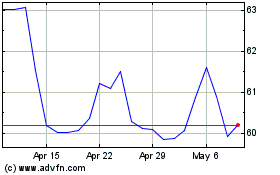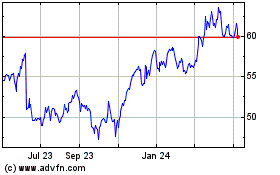NYSE, Deutsche Boerse Set To Vie For Technology Business
February 14 2012 - 4:01PM
Dow Jones News
NYSE Euronext (NYX) and Deutsche Boerse AG (DB1.XE, DBOEF) are
squaring up to compete again after burying their merger plan, and
both see selling technology and market services to other exchanges
and traders as key to their independent futures.
The Big Board operator has already laid out an ambitious plan to
more than double annual revenue from its technology arm to $1
billion by 2015, and its erstwhile partner this week detailed its
own strategy, creating a new IT and data unit to extol the virtues
of German engineering.
The world's largest exchange operators have in recent years
viewed the sale of technology services and data as a key growth
driver, mitigating the ups and down of trading fees. Selling the
hardware that powers trading and back-office services is also a
useful path for tapping growth in emerging markets.
"Exchanges today at their core are technology companies," said
Russ Chrusciel, head of derivatives risk management services for
trading technology company SunGard. "What used to be a crowd of
several hundred people on a trading floor has turned into a
conglomeration of buildings, servers and technology
architecture."
Deutsche Boerse systems already powers exchanges in Ireland,
Slovakia and Austria, while NYSE clients include markets in Japan,
Qatar and Poland. The technology arena has also drawn in rivals
like Nasdaq OMX Group Inc. (NDAQ), CME Group Inc. (CME) and London
Stock Exchange Group plc (LSE.LN).
The prospect of intensifying competition between NYSE and
Deutsche Boerse carries an added twist. The companies spent a year
talking about how they could stitch together a unified trading
system using the best pieces from each of their operations.
"There was bound to be some sort of learning process, but I'd be
surprised if either one completely opened the door" during those
discussions, said William Rhode, senior analyst for the market
research firm Tabb Group.
Representatives for NYSE Euronext and Deutsche Boerse declined
comment.
Deutsche Boerse's plan involves consolidating its existing
services in supplying price data and other market information into
a new unit that will also export the systems that run the German
company's stock and derivatives markets. Together the businesses
last year contributed about EUR92 million ($120.4 million) of
Deutsche Boerse's EUR2.3 billion ($3 billion) in sales revenue.
"In the process, we can bolster our technology leadership,
strengthen customer relations and pack a more powerful punch
overall," said Deutsche Boerse Chief Executive Reto Francioni on a
conference call with analysts Tuesday.
The German effort mirrors the Big Board's two-year-old push to
consolidate and expand its NYSE Technologies division, which now
includes two purpose-built data center facilities near New York and
London as well as a growing range of services designed pump more
market data to traders at faster speeds. NYSE Euronext on Tuesday
rolled out a new mechanism that automates some compliance
functions.
Institutional investors like mutual funds and pension plans have
begun to embrace the same tools that algorithm-driven firms, such
as high-frequency traders, have developed to scan and trade the
increasingly fragmented electronic markets. Exchanges have
responded with a broader and custom-built array of systems ranging
from cloud computing services to brick-and-mortar trading hubs
built to withstand hurricanes and bomb blasts.
"There's a tremendous amount of new regulation coming into play,
especially for the derivatives market, and that creates a need for
more automated systems," said Tyler Moeller, chief executive of
Broadway Technology LLC.
NYSE Euronext CEO Duncan Niederauer last week projected that
revenues from his company's technology services would rise at least
10% this year, up from $490 million in 2011. The company aims to
build on existing partnerships with banks like Goldman Sachs Group
(GS) and Citigroup Inc. (C), as well as foreign-based markets that
have installed NYSE Euronext-designed trading engines.
Deutsche Boerse already maintains its own portfolio of
partnerships with smaller exchanges and elsewhere has acquired
economic indicators, like the Chicago Purchasing Managers Index, to
help expand a service that feeds such numbers directly to
electronic trading firms' automated strategies.
-By Jacob Bunge, Dow Jones Newswires; 312 750 4117; jacob.bunge@dowjones.com
Nasdaq (NASDAQ:NDAQ)
Historical Stock Chart
From Apr 2024 to May 2024

Nasdaq (NASDAQ:NDAQ)
Historical Stock Chart
From May 2023 to May 2024
